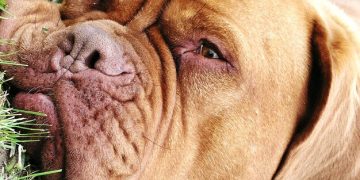Designer Dog Breeds in 2025: Profiles & Ethical Guide

Designer dog breeds, intentionally crossbred for specific traits, continue to evolve in 2025, raising ethical considerations regarding health, welfare, and responsible breeding practices, alongside the demand for these uniquely mixed canines.
With the ever-increasing popularity of canine companions, designer dog breeds: understanding breed profiles and ethical considerations in 2025, becomes crucial for prospective owners seeking informed decisions.
Understanding the Appeal of Designer Dog Breeds
Designer dog breeds have surged in popularity, but understanding their appeal requires acknowledging both the desirable traits and the potential pitfalls. These breeds, often a mix of two purebreds, are intentionally created to combine specific characteristics.
The Rise of Hybrid Vigor
One major appeal of designer breeds is the concept of hybrid vigor, also known as heterosis. This refers to the tendency of crossbred offspring to exhibit traits superior to those of either parent.
Predictability and Temperament
Many prospective owners seek designer breeds for the promise of predictability in size, coat type, and temperament. While not always guaranteed, crossbreeding can sometimes offer a more predictable outcome compared to random mixes.

Designer breeds offer the potential for combining the best traits of two distinct breeds. Here are some of the most popular designer dog breeds:
- Goldendoodle: A mix of Golden Retriever and Poodle, known for their intelligence, affectionate nature, and hypoallergenic coats.
- Labradoodle: A mix of Labrador Retriever and Poodle, similarly praised for their hypoallergenic qualities and friendly temperament.
- Cockapoo: A mix of Cocker Spaniel and Poodle, beloved for their playful personalities and relatively low-shedding coats.
- Maltipoo: A mix of Maltese and Poodle, cherished for their small size and gentle demeanor.
The appeal of designer breeds is multifaceted, encompassing the promise of hybrid vigor, predictability, and specific desired traits. However, it’s essential to approach these breeds with a clear understanding of the genetic complexities and ethical considerations.
Common Designer Dog Breed Profiles
Exploring the profiles of common designer dog breeds provides insight into their potential traits, health concerns, and care requirements. Understanding these breeds requires a focus beyond just aesthetics.
Goldendoodle: The Gentle Giant
The Goldendoodle, a cross between a Golden Retriever and a Poodle, is renowned for its friendly and intelligent demeanor. They typically inherit the Golden Retriever’s affectionate nature and the Poodle’s intelligence and low-shedding coat.
Labradoodle: Versatility and Energy
The Labradoodle, a mix of Labrador Retriever and Poodle, shares many similarities with the Goldendoodle. They are energetic, intelligent, and often possess hypoallergenic coats.

Cockapoo: The Affectionate Companion
The Cockapoo, a blend of Cocker Spaniel and Poodle, is smaller than both Goldendoodles and Labradoodles, making them suitable for apartment living. These dogs are known for being affectionate, playful, and relatively low-shedding.
Each designer breed carries its own set of potential health issues. Here are some possible concerns:
- Hip Dysplasia: Common in larger breeds like Goldendoodles and Labradoodles, this condition affects the hip joint and can lead to arthritis.
- Progressive Retinal Atrophy (PRA): This eye disease can lead to blindness and affects various breeds, including those used in designer mixes.
- Ear Infections: Breeds with floppy ears, like Cockapoos, are prone to ear infections due to poor ventilation.
- Allergies: Skin allergies can be prevalent in many designer breeds, requiring specialized care and diet.
Understanding the profiles of common designer dog breeds involves acknowledging both their desirable traits and potential health concerns. This knowledge is crucial for providing appropriate care and ensuring the dogs’ well-being.
Ethical Considerations in Designer Dog Breeding
The ethical considerations surrounding designer dog breeding are increasingly important as these breeds grow in popularity. Breeders must prioritize health, responsible breeding practices, and the welfare of the dogs.
Health Screening and Genetic Testing
Ethical breeders conduct thorough health screenings and genetic testing on parent dogs to reduce the risk of passing on hereditary conditions. This includes testing for hip dysplasia, PRA, and other breed-specific ailments.
Overbreeding and Puppy Mills
The high demand for designer breeds can lead to overbreeding and the proliferation of puppy mills, where dogs are often kept in inhumane conditions. Supporting responsible breeders helps combat these unethical practices.
Responsible breeding practices are vital for the well-being of designer dogs. These include:
- Providing Proper Care: Ensuring that parent dogs and puppies receive adequate nutrition, veterinary care, and socialization.
- Limiting Breeding Frequency: Allowing female dogs sufficient time to recover between litters to prevent health complications.
- Finding Suitable Homes: Screening potential owners to ensure they can provide a loving and supportive environment for the dog.
- Educating Buyers: Informing prospective owners about the breed’s specific needs and potential health issues.
The Role of Breed Standards
The lack of standardized breed definitions for designer dogs poses challenges in ensuring consistent traits and health. The establishment of breed standards can help improve predictability and reduce genetic defects.
Addressing ethical considerations in designer dog breeding requires a collective effort. By prioritizing health, responsible practices, and informed decision-making, we can promote the welfare of these dogs and ensure a sustainable future for designer breeds.
Health and Welfare: Common Issues in Designer Dogs
Addressing the health and welfare of designer dogs involves understanding the common issues they face and implementing proactive measures. These dogs can be predisposed to a variety of genetic and environmental health problems.
Genetic Predispositions
Designer dogs can inherit genetic predispositions from both parent breeds, increasing their risk for certain health conditions. This includes a variety of issues like hip and elbow dysplasia, heart conditions, and eye disorders.
The Impact of Early Socialization
Early socialization is critical for designer dogs to develop well-adjusted temperaments and avoid behavioral problems. Proper socialization involves exposing puppies to various environments, people, and other animals.
Addressing common health issues in designer dogs requires a multi-faceted approach:
- Routine Veterinary Care: Regular check-ups and vaccinations are essential for maintaining overall health and preventing disease.
- Nutritious Diet: Providing a balanced and high-quality diet tailored to the dog’s age, size, and activity level.
- Mental Stimulation: Engaging the dog in activities that stimulate their mind, such as puzzle toys and training exercises.
- Regular Exercise: Ensuring the dog receives sufficient physical activity to maintain a healthy weight and prevent joint problems.
Recognizing Signs of Illness
Owners should be vigilant in recognizing signs of illness in their designer dogs. This includes changes in appetite, energy level, and behavior. Early detection can improve treatment outcomes and prevent serious complications.
Promoting the health and welfare of designer dogs requires a proactive approach to addressing genetic predispositions, ensuring proper socialization, and providing comprehensive care. By understanding their unique needs, owners can enhance the quality of life for their canine companions.
The Future of Designer Dog Breeds in 2025
The future of designer dog breeds in 2025 is likely to be shaped by evolving consumer preferences, advancements in genetic testing, and increased awareness of ethical considerations. Several trends are expected to influence the landscape.
Advancements in Genetic Testing
Genetic testing will play an increasingly important role in designer dog breeding, enabling breeders to make more informed decisions and reduce the risk of hereditary diseases. These tests can identify carriers of genetic mutations.
The Influence of Social Media
Social media platforms continue to drive demand for designer breeds, influencing trends and shaping consumer preferences. Responsible breeders use these platforms to educate potential owners and promote ethical practices.
The predicted future of designer dogs relies on these aspects being developed and improved constantly:
- Greater Emphasis on Health: Breeders will prioritize health and welfare, conducting thorough health screenings and genetic testing on parent dogs.
- Expanded Breed Standards: The creation of more standardized breed definitions to offer more predictability in traits and temperaments.
- Increased Regulation: Government entities could create and enforce stricter regulations on designer dog breeding to prevent unethical practices and ensure animal welfare.
- Enhanced Public Education: Wider access to education for prospective owners will enable them to make informed decisions.
Consumer Education and Awareness
Increased consumer education and awareness will empower prospective owners to make responsible decisions, choosing breeders who prioritize health and ethical practices. This awareness extends to understanding the breed’s needs.
The future of designer dog breeds in 2025 hinges on a collective commitment to health, ethical breeding, and informed decision-making. By embracing these principles, we can ensure that designer dogs thrive and continue to bring joy to their owners.
Making an Informed Decision: Choosing a Designer Dog
Choosing a designer dog requires careful consideration and an informed decision-making process to ensure a good match for both the owner and the dog. This involves understanding the breed’s needs, temperament, and potential health issues.
Researching Different Breeds
Thorough research is essential when considering a designer breed. Learning about the parent breeds and their potential combination of traits can help prospective owners anticipate the dog’s needs. This includes considering their energy level, grooming requirements, and potential health issues.
Visiting the Breeder
A visit to the breeder’s facility is crucial for assessing the conditions in which the dogs are raised. Ethical breeders maintain clean and spacious environments, and they are transparent about their breeding practices.
Here are key items when looking at a breeder:
- View the Parents: Request to meet the parent dogs to observe their temperament and health.
- Ask Questions: Inquire about the breeder’s health screening and genetic testing protocols.
- Evaluate the Environment: Observe the living conditions of the dogs, ensuring they are clean and comfortable.
- Request References: Ask for references from previous buyers to gauge the breeder’s reputation.
Understanding the Commitment
Owning a designer dog is a long-term commitment that requires time, resources, and dedication. Prospective owners should be prepared to provide proper care, including routine veterinary visits, nutritious food, regular exercise, and mental stimulation.
Making an informed decision when choosing a designer dog involves thorough research, a visit to the breeder, and a clear understanding of the commitment. By approaching the process with care and diligence, prospective owners can ensure they are well-prepared to provide a loving and supportive home for their new canine companion.
| Key Point | Brief Description |
|---|---|
| 🐶 Breed Profiles | Understanding common traits and health concerns of popular designer breeds. |
| ❤️ Ethical Breeding | Prioritizing health screenings, responsible practices, and genetic testing. |
| 🐾 Health & Welfare | Addressing common health issues, socialization, and providing proper care. |
| 📅 Future Trends | Genetic advancements, social media influence, and increased regulations. |
FAQ
A designer dog breed is a cross between two different purebred dog breeds, intentionally bred to combine specific traits. Popular examples include Goldendoodles (Golden Retriever & Poodle) and Labradoodles (Labrador Retriever & Poodle).
While designer breeds can benefit from hybrid vigor, inheriting fewer genetic issues from diverse backgrounds, they can still be prone to health conditions common to their parent breeds. Health screenings are essential.
Ethical breeders prioritize health screenings, genetic testing, and providing optimal care for their dogs. Visiting the breeder, viewing the parent dogs, and asking detailed questions about their practices are crucial steps.
Common health issues in Goldendoodles and Labradoodles include hip dysplasia, progressive retinal atrophy (PRA), and elbow dysplasia. Regular veterinary check-ups and genetic testing can help early detection.
Early socialization is critical for designer dogs, exposing them to various environments, people, and animals to promote well-adjusted temperaments and prevent behavioral issues. Consistent and positive experiences are key.
Conclusion
Understanding designer dog breeds involves exploring their unique breed profiles, addressing ethical considerations, and prioritizing health and welfare. By making informed decisions and supporting responsible breeding practices, prospective owners can ensure a happy and healthy life for their designer dog companions.





